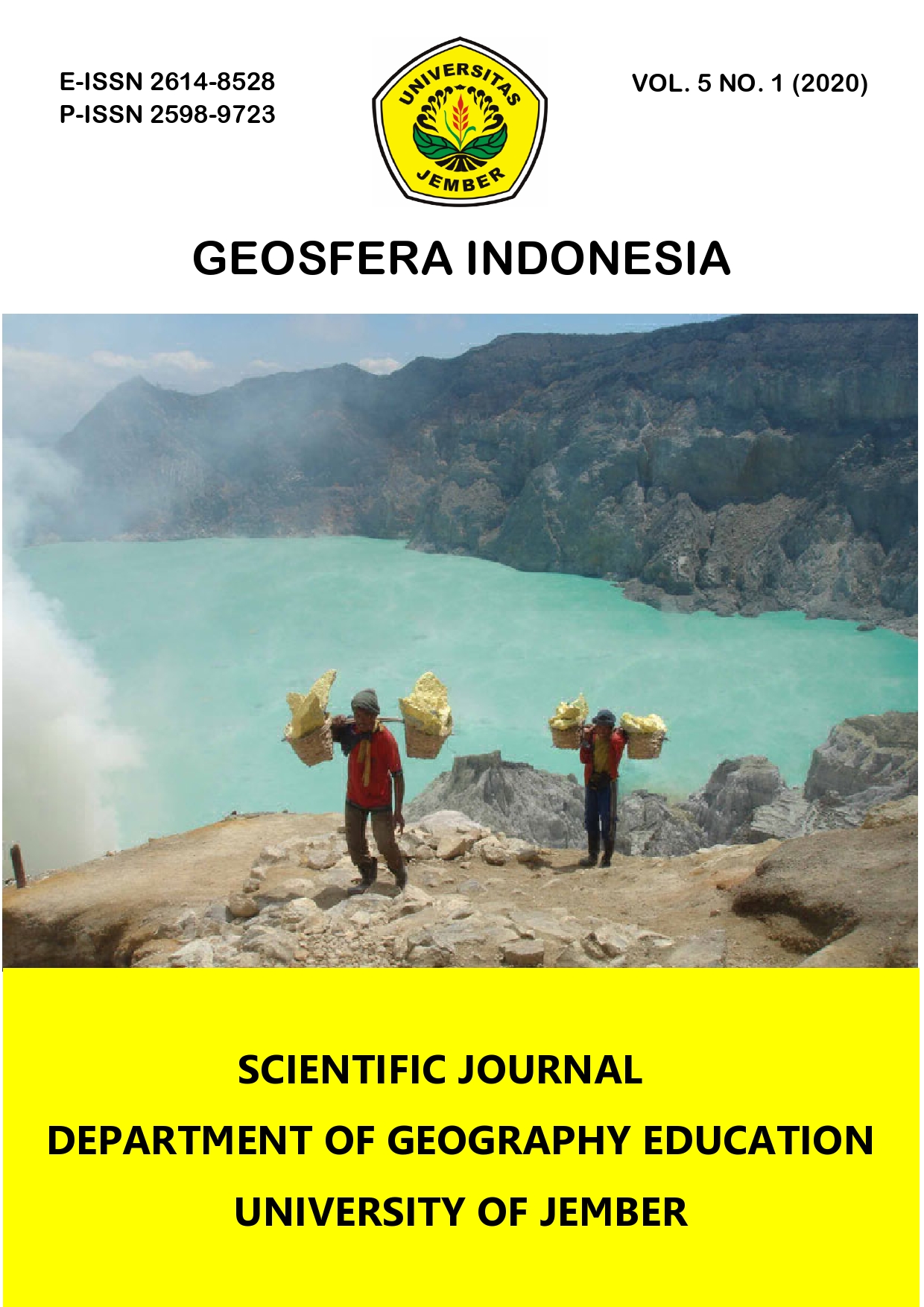Implementing Google Earth to Enhance Student’s Engagement and Learning Outcome in Geography Learning
DOI:
https://doi.org/10.19184/geosi.v5i1.11987Keywords:
Google Earth, Remote sensing, student's activitiesAbstract
Thisstudy aims to examine the effects of Google Earth on students’ engagement in learning and their learning outcome. This study employed pre-experimental design with the One-Shot Case Study design. From the exploration directed crosswise over various areas of evaluation of 12 students in the school, it is demonstrated that dynamic learning of students in was high since it was above 75% and learning outcomes reached an average of 80. This is good considering that the passing grades set in the school was 70. The application of experiential learning methods can produce satisfactory output when viewed from student participation. By looking at the characteristics of schools where students number was less than 20, the teacher is required to develop innovative learning methods. If implemented, this may yield in the improving circumstance of the currently marginalised Geography.
Keywords: Google Earth; Student`s activities; Geography learning.
Copyright (c) 2020 Geosfera Indonesia Journal and Department of Geography Education, University of Jember

This work is licensed under a Creative Commons Attribution-Share A like 4.0 International License
Downloads
References
Ademe, B. (2010). General Learning-Teaching Methods and Techniques. Addis Ababa: Addis Ababa University press.
Aydin, F., & Kaya, H. (2010). Geography teachers’ views towards vocational geographic information systems (GIS) seminar. Middle-East Journal of Scientific Research, 6(6), 631-636.
Cauley, F. G., Aiken, K. D., & Whitney, L. K. (2009). Technologies across our curriculum: A study of technology integration in the classroom. Journal of Education for Business, 85(2), 114-118.
Collins, L. (2018). Student and teacher response to use of different media in spatial thinking skill development. International Journal of Geospatial and Environmental Research, 5(3), 3.
Cuviello. (2010). Evaluating Google Earth in the Classroom. Thesis. United States Military Academy: Faculty Professional Development Program.
Drake, J. R. (2012). A critical analysis of active learning and an alternative pedagogical framework for introductory information systems courses. Journal of Information Technology Education, 11, 39-52.
Fullan, M., & Langworthy, M. (2014). A rich seam: How new pedagogies find deep learning. London: Pearson
Gökçe, N. (2015). Social studies in improving students’ map skills: Teachers’ opinions. Educational Sciences: Theory & Practice, 15(5)
Hong, J. E. (2018). Critical citizenship education through geography. International Journal of Geospatial and Environmental Research, 5(3), 7.
Jo, I., & Hong, J. E. (2018). Geography Education, Spatial Thinking, and Geospatial Technologies: Introduction to the Special Issue. International Journal of Geospatial and Environmental Research, 5(3), 1.
Johnson, N. D., Lang, N. P., & Zophy, K. T. (2011). Overcoming assessment problems in Google Earth-based assignments. Journal of Geoscience Education, 59(3), 99-105.
Marra, W. A., van de Grint, L., Alberti, K., & Karssenberg, D. (2017). Using GIS in an Earth Sciences field course for quantitative exploration, data management and digital mapping. Journal of Geography in higher education, 41(2), 213-229.
Marshall, S. P. (2009). Re-imagining specialized STEM academies: Igniting and nurturing decidedly different minds, by design. Roeper Review, 32(1), 48-60
Palmer, R. E. (2013). Learning geomorphology using aerial photography in a web-facilitated class. Review of International Geographical Education Online, 3(2), 118-137.
Patterson, T. C. (2007). Google Earth as a (Not Just) Geography Education Tool. Journal of Geography, 106(4), 145-152.doi:10.1080/00221340701678032
Phadke, R. (2010). Defending Place in the Google Earth Age. Ethics, Place & Environment, 13(3), 267-281.doi:10.1080/1366879X.2010.516495
Prawindia, L., Fatchan, A., & Astina, I. K. (2016). Pengembangan Bahan Ajar Geografi Struktur Buku Cambridge Fundamentals of Geography untuk Kelas XI SMA/MA Materi Sebaran Barang Tambang. Jurnal Pendidikan Geografi: Kajian, Teori, dan Praktek dalam Bidang Pendidikan dan Ilmu Geografi, 21(1), 53-62.
Samson, P. L. (2015). Fostering student engagement: Creative problem-solving in small group facilitations. Collected essays on learning and teaching, 8, 153-164.
Thankachan, B., & Franklin, T. (2013). Impact of Google Earth on student learning. International Journal of Humanities and Social Science, 3(21), 11-16
Yuda, M. (2011). Effectiveness of digital educational materials for developing spatial thinking of elementary school students. Procedia-Social and Behavioral Sciences, 21, 116-119.
Yunus, H.S., (2010). Metodologi Penelitian Wilayah Kontemporer, Yogyakarta : Pustaka Pelajar
Downloads
Published
How to Cite
Issue
Section
License
Copyright (c) 2020 Geosfera Indonesia

This work is licensed under a Creative Commons Attribution-ShareAlike 4.0 International License.



